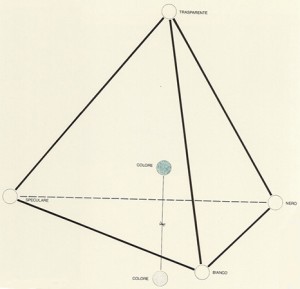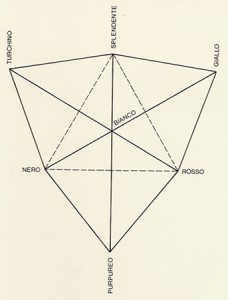
The CMN system was first introduced in Venice, 1986. Colours transform; they get brighter and darker until they eventually become white or black, as well as altering the quality of transparency and reflectiveness. The system shows why and how colours appear, change and disappear. Eat point of the tetrahedral structure marks the different qualities in reflectiveness, transparency, brightness and darkness the colour can posses. This single tetrahedron can be combined with others and create a complete range of spacial models required to find the origins of the colour as well as reflect the intentions of the observer. Despite transparency and reflection stemming from an object which is illuminated, the colours appearing will be the result of the contribution made by the observer. The effect these two qualities have on colours is at the forefront of this colour system, as it is the first to consider transparency and reflection in a colouring ordering system.
The tetrahedron construction was a form first seen in Plato’s geometrical idea of colour. The radiance must appear along side the colours and have equal value, only white being allowed dominance. The tetrahedron is taken as a basis, three can be assembled with their tip representing white interlocking acting as the central point and remains colourless. This forms a second triangular plane with a colour appointed to eat corner. The white centre being empty allows colours to be mixed. This idea given by Plato is not a formally constructed colour system, rather the personal view is intended to aid understanding the colour mixtures he describes.

